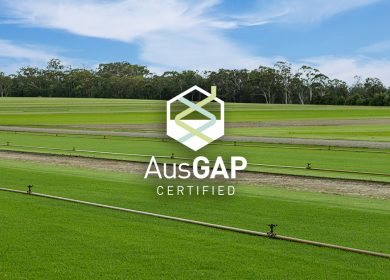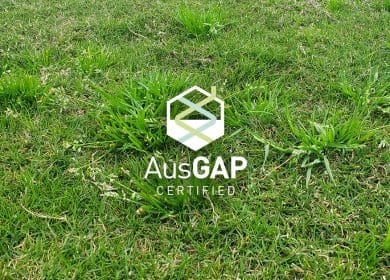Benefits of Organic Biostimulants for Turf

Organic biostimulants what are they? They are products such as plant hormones, vitamins, enzymes, humic and fulvic acid, sugars, kelp/seaweed extracts, fish emulsion and other products.
Biostimulants when used correctly can aid in turfgrass growth and metabolism, increase root mass, and increase soil microorganisms. You can add them to existing fertiliser programs or use them solely. Functions of each product vary from stimulating soil microorganisms, reducing growth, stimulating growth, increase crop yield, and improve plant health.
The following are probably the most used biostimulants across the turf commercial and domestic markets.
1. Kelp/Seaweed Extracts
Kelp/Seaweed is high in carbohydrates, making them a great source of food for turf. It is also low in in cellulose and breaks down easily, making it a perfect source of nutrients for your lawn.
It may be strange that a product produced from plants from the sea could be beneficial to turf, but the natural and organic product is rich in valuable minerals, cytokinin’s, and antioxidants.
Benefits of Kelp/Seaweed Extracts
- Increases root growth.
- Improves overall appearance in colour, turf density, and hardiness.
- Enhances natural resistance to stresses such as disease, drought, and insect pressures.
- Increases nutrient levels and uptake in plants.
- Promote microorganism active in soils and can aid reduction of soil leaching.
- Increases plant carbohydrate production, which enhances grass root and blade development.
- Increases photosynthesis and chlorophyll production.
Disadvantages of Kelp/Seaweed Extract
- Some Kelp/Seaweed extracts are extremely Alkaline in nature and care must be given when mixing with Chemicals and nutrients like Calcium. High Alkaline products can reduce the efficacy of chemistry and cause nutrient dropout.
2. Fish Emulsion
Fish Emulsion can be classed an organic biostimulant or as a fertilizer. It is a by-product of fish processing and is obtained when the fish is cooked and pressed to extract the oil. When applied it tends to leave fish smell that usually only lasts a couple of days.
Benefits of Fish Emulsion
- Can contain higher levels of organic acids that may have be helpful in suppressing disease.
- Fish Emulsion stimulates fungal growth in soils. Grasses prefer fungal dominated soils compared to bacterial dominated soils.
- The Nitrogen form is Protein Nitrogen in the form of amino acids. These need to be broken down into ammonium form of Nitrogen by biologicals in the soil.
- Amino Acids are helpful in reducing stress factors, ie; frost, heat and wind stress.
Disadvantages of Fish Emulsions
- Fish emulsion can have low amounts of NPK. It may also contain trace elements of Mg, Ca and other minerals.
- Short lived fertilizer that needs to be applied frequently. Twice a week is necessary for some plants.
- It is acidic. In its diluted form, the acidity should not be a problem with most plants unless you already have overly acidic soil.
3. Humic Acid
Humic acid is a product made of decomposed organic material. As it is an organic-based amendment it can assist in optimising existing soil microbiological and accelerating early stages of plant nutrition.
Benefits of Humic Acid
- Increase in the soil microbial population including beneficial microorganisms. Especially bacteria’s.
- Improve soil structure
- Increase in the cation exchange capacity and the pH buffering capacity of the soil
- Mitigate localised Dry Spot (LDS) and excessive soil nutrient leaching
- Aid the uptake of iron and Zinc and maintained adequate levels of other micronutrients to help retain
- Humic acids are best used when applying Nitrogen. Nitrogen is readily leached when water moves below the root zone especially in sandy soils. The Humic acid help to hold the Nitrogen in the soil (especially sandy soils) and is an excellent food source to attract the biologicals to the Nitrogen to convert into nitrates for plant availability by a process called Nitrification.
Disadvantages of Humic Acid
- Humic Acids are extremely Alkaline, most range between pH 11 – 13 and care must be taken when mixing with Chemicals and nutrients.
- Humic Acid is incompatible with Calcium due to its alkaline nature. Can also cause other minerals to drop out of solutions
4. Fulvic Acid
Fulvic acid is a yellowish-brown substances found in natural material such as shilajit, soil, peat, coal, and bodies of water such as streams or lakes. Fulvic acid is formed when plants and animals decompose and is extracted from Humic Acid.
Benefits of Fulvic Acid
- Acid in nature, pH 3 – 5
- Fulvic acids are an excellent organic chelating agent. Increase the availability of nutrients and minerals as a foliar and soil fertigation.
- Fulvic Acids increase cell wall permeability increasing nutrient and chemical availability.
- Due to the acidic nature they will acidify around the root zone helping to unlock bound nutrients in the soil profile.
- Compatible with Calcium.
- Lower spray tank water pH to reduce pesticide hydrolysis.
- Compatible with all nutrients
Disadvantages of Fulvic Acid
- To date there has not been any recorded data of the disadvantages of Fulvic Acid on turf, this could be due to its benefits of use during application, to the turf plant and the soils.


